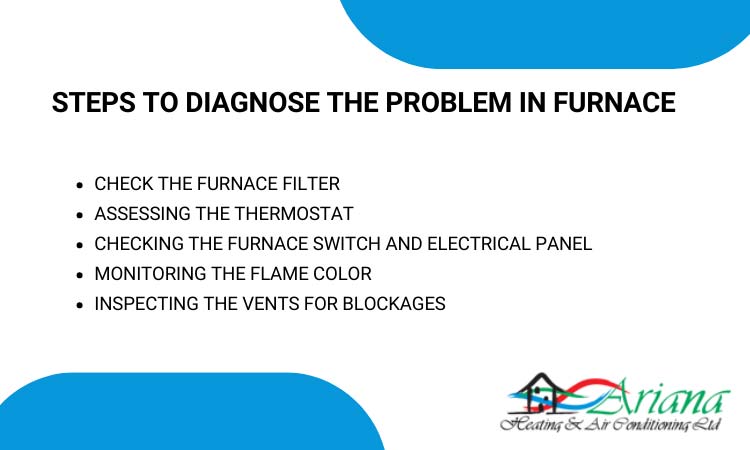FAQ
Helpful Insights on HVAC Repairs, Costs, and Preventive Care
FAQs
Helpful Insights on HVAC Repairs, Costs, and Preventive Care

How To Diagnose a Furnace Problem
Winter weather in regions like Vancouver, Burnaby, Surrey, Coquitlam, Langley, Maple Ridge, Port Moody, Richmond British Columbia brings about the need for a functional and efficient home heating system. One such system, upon which many homeowners rely, is the furnace. While furnaces are a reliable means of heating, they can experience technical issues over time.
Understanding how to diagnose a furnace problem is a vital skill for homeowners to ensure consistent comfort. This guide will provide you with an in-depth understanding of how to troubleshoot potential issues before reaching out for professional "furnace service near me".
The Importance Of A Furance In Maintaining A Comfortable Home Environment
Without a furnace, enduring the harsh winter months could be a daunting task. Many of us would be forced to resort to archaic methods of staying warm, like huddling around a bonfire, which is neither practical nor healthy.
Furnaces, particularly electric and gas furnaces, provide consistent, regulated heat.However, they require regular check-ups and maintenance to prevent malfunctioning. If despite your best efforts, your furnace is causing problems, diagnosing them is the first step towards resolution.

STEP I: Investigating The Furnace Filter
Furnace filters play a critical role in ensuring that the airflow from your furnace is clean and free from dust or other pollutants. Over time, filters can accumulate dust and grime, restricting airflow and compromising the indoor air quality. This restriction can prevent the furnace from functioning optimally or even cause severe issues like fire hazards.
When inspecting your furnace filter, start by switching off the furnace and the thermostat. It's a good practice to set monthly reminders to clean or replace the air filters. If a replacement is needed, ensure the new filter is installed correctly, with the access panel secured.
STEP II: Assessing The Thermostat
The thermostat controls the temperature of your home and interacts directly with your furnace. When it's working properly, it triggers the furnace to produce heat once the temperature drops below the set point.
To verify its functionality, set the thermostat to at least five degrees higher than the room temperature. The furnace should kick in, and the room should start to heat up. If it doesn't, your thermostat might require new batteries. If it's an older, electromechanical model, it might require some cleaning. Use a soft brush or cloth to gently dust off the metal coils and contact plates.
Ensure the thermostat is situated away from direct sunlight or other heat sources, as these can interfere with accurate temperature readings.
STEP III: Checking The Furnace Switch And Electrical Panel
Every furnace has a switch, usually located on or near the unit. If the furnace isn't working despite the switch being on, turn it off, then open the electrical panel. Confirm the breaker for the HVAC system is on. If it's off, you need to restore power. Check for a blown or melted fuse and replace it with a similar new fuse.
STEP IV: Monitoring The Flame Color
The color of the flame in your furnace can reveal a lot about its health. An efficiently burning furnace will have a flame that's mostly blue with a yellow tip. If the flame is a different color, it indicates that the furnace is not burning fuel properly, and you should immediately contact a professional for "furnace maintenance service near me."
STEP V: Inspecting The Vents For Blockages
Sometimes, even when the furnace seems to be working correctly, the rooms may not get adequately heated. This could be due to obstructions in the supply and return grills across the house. Blockages can create air pressure imbalances, leading to duct leaks and even system breakdowns. Ensure all vents are clean and unclogged for efficient heating.
Conclusion: When To Call In The Professionals
The aforementioned steps can help homeowners undertake basic troubleshooting of their electric furnace. However, some issues might require a professional's expertise. Never hesitate to call a furnace repair service if you're unsure about handling a particular problem.
Ariana Heating & Air Conditioning Ltd. is your go-to solution for furnace issues in Vancouver and surrounding areas. Our services span "furnace repair Vancouver," "furnace installation Vancouver," "furnace cleaning near me," and "furnace repair near me," ensuring your home stays warm all winter.
Additionally, we offer emergency furnace repair for those unexpected breakdowns. If you're considering a new "electric furnace for house," we can guide you through the furnace installation process and give you an accurate "furnace installation cost."
Our team is also equipped to handle "gas furnace repair near me," "oil furnace repair near me," and "furnace tune up near me." Plus, we can give you a quote for "furnace and AC replacement cost" if you're considering an HVAC overhaul. For an in-depth cleaning, our "furnace cleaning" service ensures your system runs smoothly, while our "furnace maintenance service near me" keeps your furnace in optimal condition.
In addition to furnace-related services, we also offer comprehensive HVAC services. These include "hvac replacement near me," "emergency hvac repair," "emergency hvac repair near me," "24 hour hvac repair," "hvac control board replacement," and services for specific brands like "lennox hvac repair near me" and "carrier hvac repair." We also specialize in "hvac furnace cleaning," "hvac repair and installation," and offer a "hvac tune up service near me."
Looking for affordable HVAC solutions? Our "affordable hvac replacement" services, along with services for specific brands like "bryant hvac near me," can cater to your needs. If you're concerned about the cleanliness of your HVAC system, we can guide you on the "cost of cleaning hvac ducts." For those considering adding a humidifier, we provide "home hvac humidifier," "hvac furnace installation," "new hvac install," "whole home humidifier hvac," and "installing hvac ducting" services.
At Ariana Heating & Air Conditioning Ltd., we strive to offer comprehensive services for all your heating needs. If you encounter a problem with your furnace or HVAC system, don't hesitate to call us at (604) 466-0072. Our team of professionals is always ready to help.
Frequently Asked Questions
Need Help? Find Quick Answers to Common HVAC Concerns
Q: Do I Need to Cover My Heat Pump in the Winter?
No, covering your heat pump during winter is not recommended. These units are designed to operate in all weather conditions, and covering them can restrict airflow and cause moisture buildup, potentially damaging the system.
Q: How Can I Find the Unit Size That Matches My House?
Determining the appropriate HVAC unit size depends on factors like your home’s square footage, insulation quality, number of windows, and more. A detailed load calculation by professionals can help identify the right unit size for optimal comfort and efficiency.
Q: Is It Safe to Plant Shrubs or Flowers Around an Outdoor Unit?
While landscaping can enhance aesthetics, it’s important to maintain at least a two-foot clearance around the outdoor unit to ensure proper airflow and ease of maintenance. Regular trimming is advised, especially in areas with rapid vegetation growth.
Q: Should a Thermostat Be Set to the “Auto” or “On” Position?
Setting the thermostat to “Auto” is generally recommended for energy efficiency, as the fan operates only when heating or cooling is needed. However, the “On” setting can provide continuous air circulation, which may be preferred for consistent airflow and filtration.
Q: What Do Rating Numbers Mean?
HVAC systems have efficiency ratings like SEER (Seasonal Energy Efficiency Ratio) for air conditioners and heat pumps, and AFUE (Annual Fuel Utilization Efficiency) for furnaces. Higher ratings indicate better energy efficiency, leading to cost savings and environmental benefits.
Q: What Does AFUE Stand For?
AFUE stands for Annual Fuel Utilization Efficiency, representing the percentage of fuel converted into usable heat by a furnace. A higher AFUE rating signifies a more efficient furnace.
Q: What Is the Difference Between a Split System and a Package Unit?
A split system consists of separate indoor and outdoor units, commonly used in residential settings. A package unit combines both components into a single outdoor unit, often used in commercial applications or homes with limited indoor space.
Q: What Does SEER Stand For?
SEER stands for Seasonal Energy Efficiency Ratio, measuring the efficiency of air conditioners and heat pumps. A higher SEER rating indicates greater energy efficiency.
Q: What Is HSPF?
HSPF stands for Heating Seasonal Performance Factor, assessing the efficiency of heat pumps in heating mode. A higher HSPF rating denotes better energy efficiency.
Q: When Replacing an Outdoor Unit, Do I Need to Replace the Indoor Unit Too?
It’s advisable to replace both units simultaneously to ensure compatibility and optimal efficiency, as mismatched components can lead to performance issues.
Q: Who Do I Contact for Heating and Cooling Products and Services?
For comprehensive HVAC services, you can contact Ariana Heating & Air Conditioning Ltd at (778) 861-7120 or via email at [email protected].
Furnace and Heating Systems FAQs
Q: How Can I Know When It Is Time to Replace My System?
Indicators include the system’s age (typically 15-20 years), frequent repairs, rising energy bills, and inconsistent heating. A professional assessment can determine if replacement is more cost-effective than repairs.
Q: How Long Does It Take to Install a System?
Installation time varies based on system type, accessibility, and additional ductwork requirements. Generally, it can range from a few hours to a couple of days.
Q: How Often Do I Need to Replace the Furnace Filters?
It’s recommended to replace furnace filters every three months. However, this can vary depending on filter type, air quality, and presence of pets.
Heat Pumps FAQs
Q: How Do I Know If My System Is Working Properly?
Signs of issues include unusual noises, high energy bills, frequent cycling, or uneven temperature control. If you notice any of these, it’s advisable to have your system evaluated by professionals.
Q: How Should I Maintain My Heat Pump?
Regular maintenance includes cleaning coils and filters, checking refrigerant levels, and ensuring secure electrical connections. Professional maintenance services can help keep your system running efficiently.
Q: What Are the Advanced Features to Look for in a Heat Pump?
Modern heat pumps may feature variable speed motors, smart thermostats, and noise reduction technologies. High-efficiency models often have elevated SEER and HSPF ratings.
Q: What Is a Heat Pump?
A heat pump is an HVAC system that provides both heating and cooling by transferring heat between the indoors and outdoors, depending on the season.
Electronic Air Cleaners FAQs
Q: How Do I Clean My Electronic Filters?
Turn off the air cleaner, remove pre-filters and collection cells, vacuum them gently, then soak in warm water with mild detergent for 15-20 minutes. Rinse thoroughly and let them dry completely before reinstalling. Always refer to the manufacturer’s manual for specific instructions.
System Maintenance FAQs
Q: Do I Need a Preventative Maintenance Agreement?
Yes, it ensures regular check-ups and tune-ups, leading to optimal performance, energy efficiency, and extended equipment lifespan. It also helps identify potential issues early.
Q: Do I Need Maintenance on Both My Indoor and Outdoor Unit?
Absolutely. Both units work together to heat or cool your home efficiently, so regular maintenance for both is essential to prevent inefficiencies and potential breakdowns.
Q: How Often Should I Change My Filter?
Check your filter monthly and replace it at least every three months. In environments with high dust levels or pets, more frequent changes may be necessary.
Q: I Have Water Draining on My Floor; Why Does This Happen?
This could indicate a blocked condensate drain, malfunctioning condensation pump, or a frozen evaporator coil. It’s best to contact professionals to diagnose and fix the issue.
Q: What Is the Benefit of Having a Preventative Maintenance Agreement?
Benefits include improved energy efficiency, extended equipment lifespan, consistent indoor comfort, lower utility bills, and fewer unexpected repairs. Regular maintenance also enhances indoor air quality.
Copyright © 2025 Ariana Heating & Air Conditioning Ltd. All right reserved.

